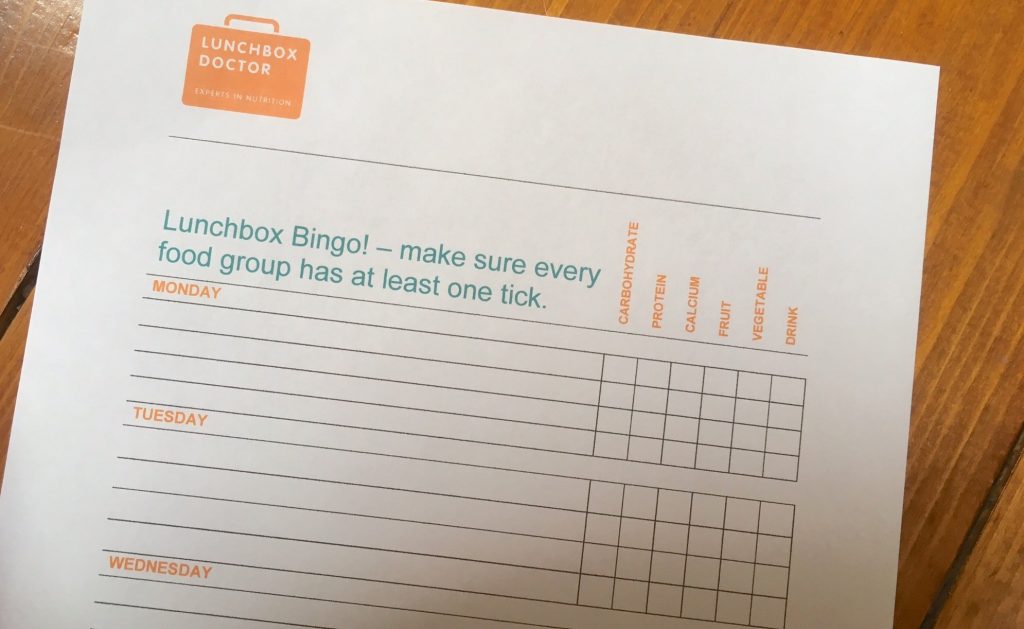
Lunchbox Bingo – How To Get The Kids To Choose Healthy Lunches
As someone who specializes in lunchboxes I really wanted to find a way of getting my own children both involved in and empowered by the decision-making process when it came to packing their lunches. After some time and through trial and error I found using this simple worksheet was a great way to get them involved. They could choose their own lunches provided they write what they wanted (in the early days I helped them with the writing part) and provided that each of the food groups had at least one tick in it each day of the week. This system is still deployed today. Sometimes it is in the physical form of this worksheet and at other times, often when we are in the shop, it is referred to verbally. I find the kids need reminding of each of the components of a balanced lunchbox rarely now. They could probably reel them off in their sleep in fact!
For those new to this way of creating balanced lunchboxes this is how the system works. You explain to your children what each of the components (food groups) does in terms that are suitable to their age:
Carbohydrate = energy food
Protein = growing food
Calcium = strong teeth and bones
Vegetable = stops you catching illnesses and missing school/soccer/dance
Fruit = stops you catching illnesses and missing school/soccer/dance
Drink = helps you concentrate for longer
Then you give them some examples from each group.
Ideal Carbohydrates for a Lunchbox:
Pitta Pockets (with a filling of a protein such as egg or tuna and a vegetable such as sweetcorn or tomato)
Wholegrain or gluten free pasta (with cream cheese, pesto or tomato sauce and cooked vegetables)
Multi-grain wraps (with a filling of a protein such as cheese, ham or hummus and a vegetable such as lettuce or cucumber)
Rice (as a rice salad with vegetables and a dressing) or rice cakes
New potatoes in their skins (made into a potato salad)
Flapjacks (sweet or savoury)
Popcorn
Tortilla chips
Root vegetable crisps
Root vegetable soups
Ideal Proteins for a Lunchbox:
Cold, lean roast meats such as beef, pork, lamb or chicken
Dips made from pulses e.g. hummus, white bean dip
Cheese, cream cheese, yogurt.
Good quality sausages – ideally 90% meat or more
Eggs – boiled, or made into an omelette, frittata or mixed with rice
Seeds or Nuts*
*If nuts allowed in your child’s school
Pulses – lentils, chickpeas
Tofu/Tempeh
Ideal Calcium Foods for a Lunchbox:
Carton of milk
Yogurt – ideally natural yogurt with a topping or fruit puree or fresh or frozen fruit added to reduce intake of simple sugars
Cheese
Spinach muffin
Broccoli spears with a cream cheese and garlic dip.
Sesame seed bars
Seed bars
Hummus
Nut bars*
Flapjacks with seeds and nuts*
Nuts*
*If nuts allowed in your child’s school
Ideal Vegetables for a Lunchbox:
Crudités i.e. carrots, peppers, cucumber chopped into sticks (served as they are or with a dip like salsa or hummus)
Vegetable muffins and flapjacks
Olives
Sweetcorn (mixed into tuna and mayonnaise as a sandwich filling or alone)
Tomatoes, olives as a pizza on a stick (with cheese, pineapple and ham on a cocktail stick)
Beetroot (plain or pickled)
Root vegetable crisps
Ideal Fruits for a Lunchbox:
Banana, apple, orange, pear
Berries, cherries
Nectarines, peaches
Figs
Dried apricots
Fruit muffins and flapjacks
Carrot cake (home-made so you know how much carrot has gone into it!)
Apple or other fruit puree (mixed into yogurt)
Ideal Drinks for a Lunchbox
Cartons of milk
Home-made fruit smoothies or milkshakes
Shop-bought fruit and vegetable smoothies
Fruit juice and water mixed
Water
Fruit juice and sparkling water mixed
Then, all you need to do is print off a copy of this worksheet for your child ahead of the next week and get them to fill it in. Then you really are both ‘on the same page’ when it comes to planning and packing healthy packed lunches.
